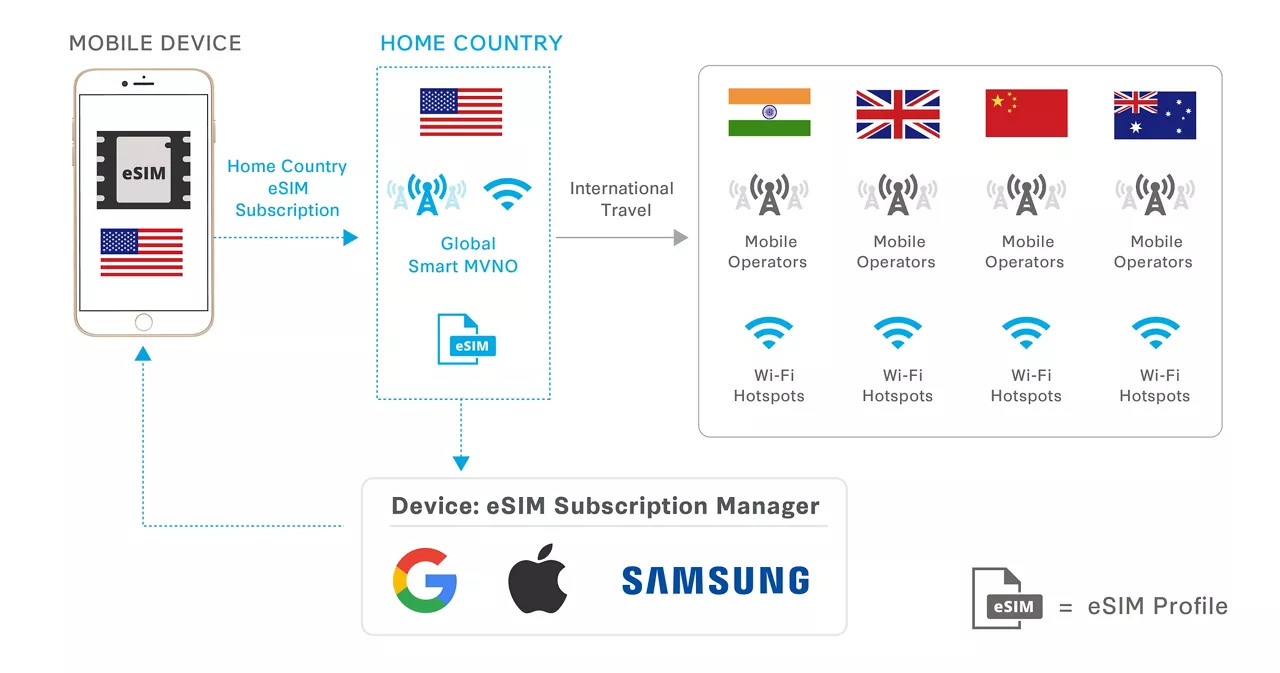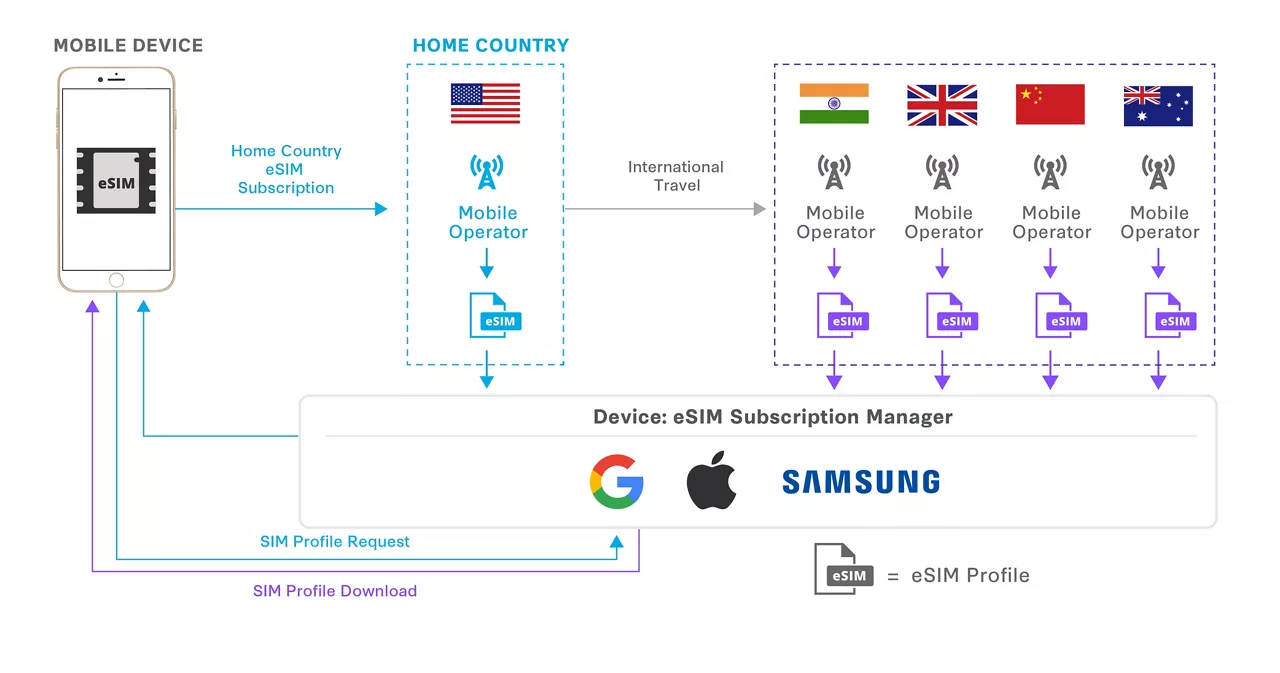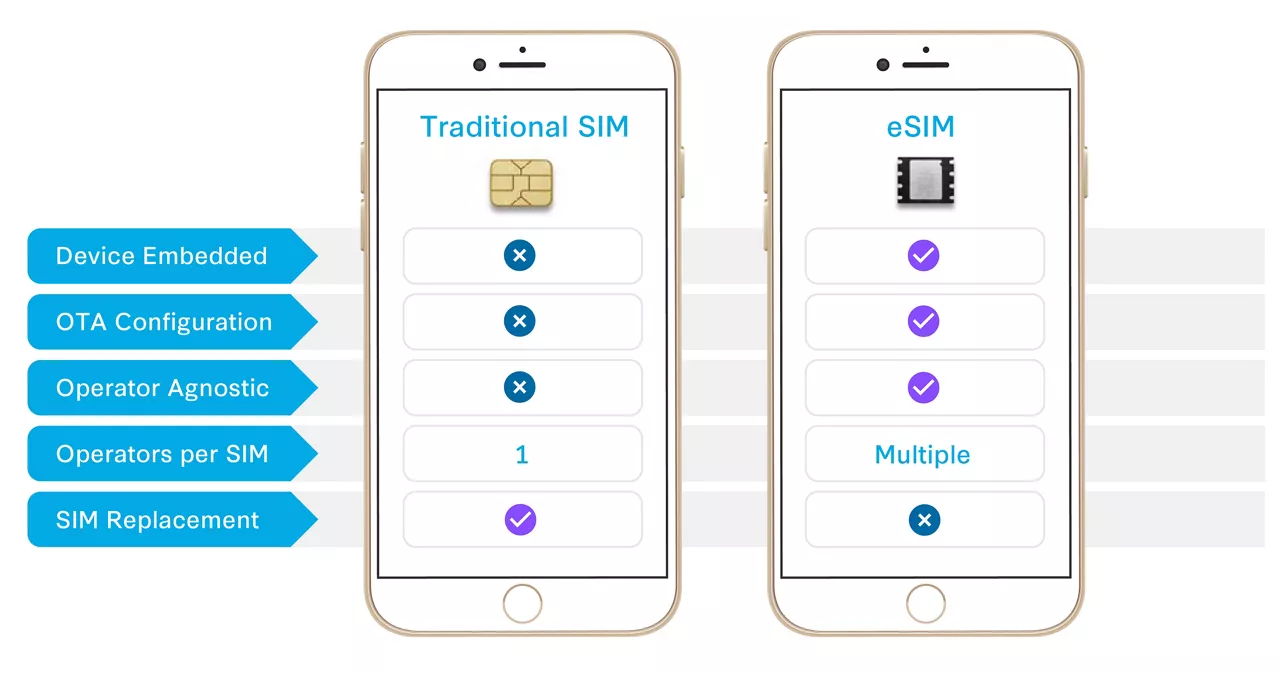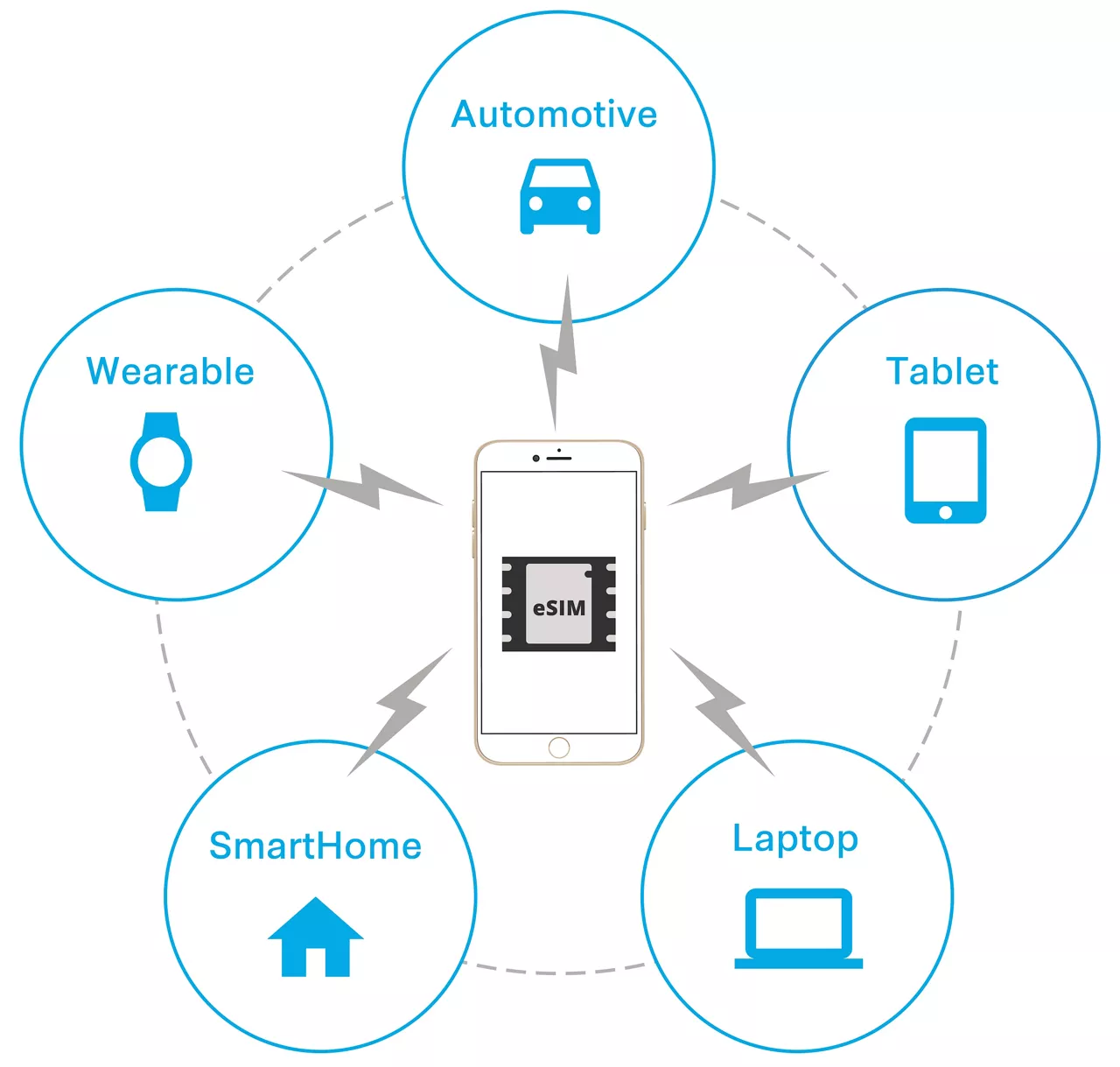Telcos’ quest for customer-centricity: Fixing data gaps to deliver what users truly need | Read the report
Virtusa Recognized as Global Leader in Gen AI Services by ISG Provider Lens® - Read report
eSIM: The gateway to global connectivity
The traditional SIM plays an important role in locking a mobile user to a mobile operator. The quality of a customer's mobile connection at a location is directly impacted by availability and bandwidth of the mobile operator's underlying network at that site. While traveling outside the home country, mobile customers today must pay exorbitant fees to their mobile operators for data and voice roaming to maintain the same seamless connectivity they have back home. Customers do have the alternative of visiting a local mobile store in the host country to buy a new SIM card (aka local phone number with data package) and replace current SIM card (losing home phone number) or put new local SIM in a dual SIM or spare phone. However, there is often inconvenience, cost, complexity, and difficulty in connecting back to the home country.
Seamless global connectivity looks like a distant dream today. Before the introduction of nation-wide mobile plans few years back, even roaming in one's own home country was a big hassle. Over-the-top (OTT) players, such as WhatsApp and Viber, who provide voice and messaging services over a data connection have made global connectivity a bit easier, but still require mobile users to be connected to the data pipe, using connectivity from data roaming, local data connection (aka local SIM card), or limited Wi-Fi hotspots.
As eSIM technology takes-off widely, global connectivity issues are going to be resolved for good. The traditional SIM is linked to a single mobile operator, and this link can't be changed. For a customer to connect to a new mobile operator, he/she must get a new physical SIM for that operator and replace the current SIM with a new SIM. Conversely, the eSIM is a non-removable SIM hardware integrated into the device. eSIM allows users to store multiple mobile operator profiles and can be programmed to use a specific profile or change a profile at any time over-the-air (OTA) without the need for a physical SIM replacement or visit to any physical store (see exhibit 1)
Exhibit 1: Traditional SIM vs. eSIM
eSIM as a concept was developed to broaden the connectivity options for wearables, but after GSMA published the eUICC (Embedded Universal Integrated Circuit Card) specification, it is now also catching up with smart phone. eSIM enables out-of-the box connectivity of the device to a mobile network, irrespective of the place the device is deployed. Once eSIM devices are widely available, it will disrupt the entire Mobile Industry value-chain, significantly impacting customers, device manufacturers, OTT players, and mobile operators.
Device manufacturers to own the customer relationship and the rise of "Global Smart MVNOs".
Until few years back, almost all mobile operators provided free or subsidized "locked" mobile phones with a 1-2 year mobile plan contract. Some mobile operators still offer that, but with the advent of eSIM, the change of role looks inevitable. With eSIM built into the device (smart phone, wearable etc.), device manufactures will enable out-of-the box connectivity, enabling device manufacturers to own the customer relationship and reduce the role of mobile operators to connectivity enablers.
The new Apple iPad released in 2018 has Apple SIM (software SIM, not eSIM) that allows users to compare, select, and pay for local mobile plans from partner mobile operators directly from the convenience of the device. Without visiting any store, a user can change the mobile data plan or the operator anytime over-the-air. Apple has partnered with mobile operators across 180 countries; its US partners are AT&T and T-Mobile.
Google Project Fi has taken the eSIM and Mobile Virtual Network Operator (MVNO) concept to a new level. Google Project Fi supports few select smartphones (with equivalent of eSIM inside) and provides global mobile plans (voice and data) to its US subscribers. Project Fi has the unique ability to connect its subscribers to the best available "data connection" at a place, seamlessly switching between its partner Wi-Fi hotspots and Mobile Network Operators, giving best of breed connectivity to its subscribers. Google Project FI has signed-up with MNOs across 170 countries; its US partners are Sprint, T-Mobile, and US Cellular.
With eSIM, device manufacturers like Apple, Google, and Samsung can take the customer relationship to the next level by bundling connectivity with a device rental plan. They can also provide basic connectivity for free and offer more advanced mobile plans with value added services for a premium.
Current MVNOs will face a serious threat from the device manufacturers as manufacturers may themselves become MVNOs, driving smaller MVNOs out of business. With eSIM built into the device, even OTT players can provide data packages and charge through Google Play, Apple Store, or Samsung Pay accounts. For example, Amazon Prime and WhatsApp can provide basic data connectivity for free through MNO partners and allow users to subscribe to advanced global data packs through their apps.
With the onslaught of eSIM, the Mobile Industry will see the rise of "Smart Global MVNOs" that provide seamless global connectivity solutions that leverage the best signal at any given location, among available Wi-Fi networks, owned networks (exampleGoogle Fiber or Comcast Xfinity) or partner MNO networks.
Customers finally get seamless global connectivity
Mobile users will be the biggest beneficiary of the eSIM revolution. Users can compare various mobile operators in the region based on cost, network speed, and quality, before choosing and provisioning the service directly from the device, avoiding any visit to the local mobile store or replacing the current SIM card. Alternatively, users will be able to buy mobile connectivity from a Smart Global MVNO, which can either be a device manufacturer (like Google, Apple, Samsung etc.) or an OTT Player (like Amazon, WhatsApp etc.) without worrying about the underlying mobile network providers. eSIM will increase competition among mobile operators, leading to non-committal data plans at reasonable price points. Some OTT service providers, like Amazon Prime, may even provide complimentary data plans.

eSIM will make international roaming redundant as Smart Global MVNOs will enable seamless global connectivity (see exhibit 2). Alternatively, mobile users can opt for an additional local provider in a host country directly from the convenience of the device (see exhibit 3).

Maintaining status quo will lead to Mobile Operators losing a direct relationship with customers
Mobile operators have been at the center of Mobile Industry value chain for a long time, raking significant revenues from device sales, International Direct Dialing (IDD), international roaming, data, voice, and messaging services. With the ascent of OTT players over the last few years, voice, messaging, IDD, and international roaming revenue have been significantly reduced. eSIM has the potential to make device manufacturers the center of the Mobile industry value-chain, leading to mobile operators losing a direct relationship with the customer.
In the short term, mobile operators can significantly benefit from eSIM growth as remote provisioning reduces the requirement for physical stores, leading to significant cost savings. Since no physical SIM card is necessary, supply chain can also be simplified, leading the way for mobile operators to become "Digital Mobile Operators (DMOs)" with limited or no physical presence. Customer service can also be extensively automated with Robotic Process Automation (RPA) and Machine Learning (ML) to reduce the cost of operations further.
However, over mid to longer term, Mobile Operators's customer connect will be significantly reduced as customers might buy mobile connectivity directly from the device manufacturer or OTT players. Since customers won't be coming to a physical store, the opportunity to up-sell mobile services or cross-sell device accessories will be substantially reduced. Subscribers may also demand freedom from contractual lock-ins, leading to high churn rate. Global Smart MVNOs that provide global connectivity packages will potentially eliminate international roaming revenues.
What can Mobile Operators do to stay relevant?
To stay relevant in this new and very competitive environment, mobile operators need to strategically work on the following options:
- Create "best network" with high reliability and accessibility and improve "network and operational efficiency" to provide great connectivity to Mobile and IoT devices at competitive cost
- Increase customer stickiness by bundling media services and other value-added services such as banking, insurance, or traditional as quad play offerings (broadband, mobile, fixed voice and TV/media services)
- Provide best in class customer service digitally using "experience stores"
- Create a consortium of Global MNOs (like Star Alliance in the airline business) to provide global connectivity solutions without roaming charges to match Smart Global MVNOs offerings
- Use the eSIM profile to connect all devices of a subscriber seamlessly with multi-device pricing plans and connectivity solution (see exhibit 4).
Exhibit 4: Mobile Operators leveraging subscribers eSIM profile across all connected personal devices
Conclusion: eSIM revolution will lead to Global Mobile Connectivity
The eSIM revolution will significantly impact the Mobile Industry value chain and make "global connectivity" a dream come true. With global mobile plans from Smart Global MVNOs", customers across the globe will be able to connect as freely and seamlessly as email connectivity today. Consumers and device manufactures will be the real beneficiaries of this transformation. Mobile operators across the globe have opportunity to become pure "Digital play" with very few to no physical stores, creative bundled offerings for current customers to keep them directly connected, and improved network and operational efficiency to stay relevant in the future.

